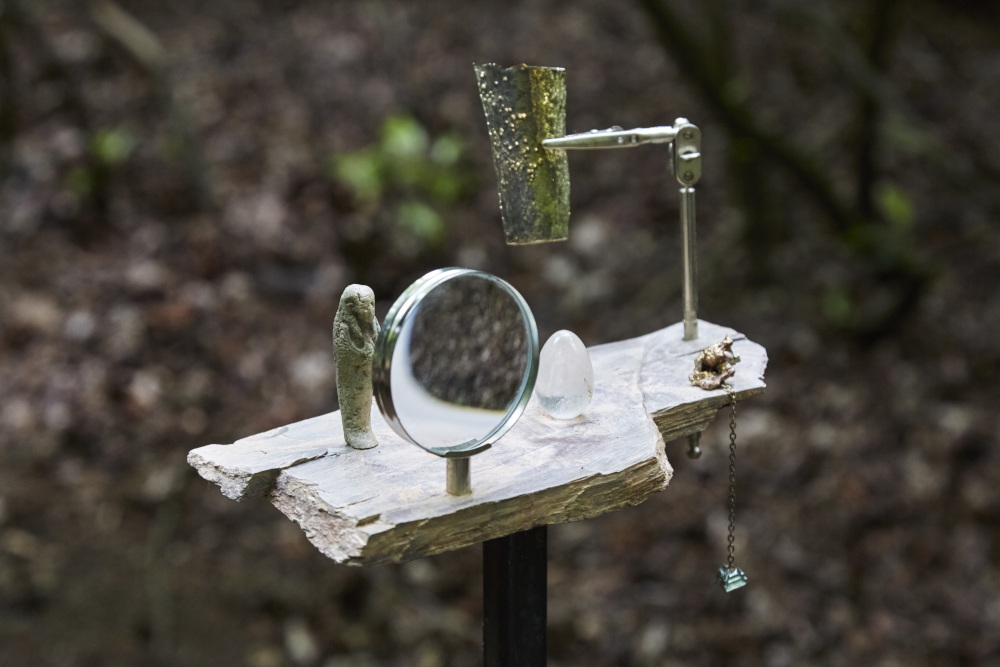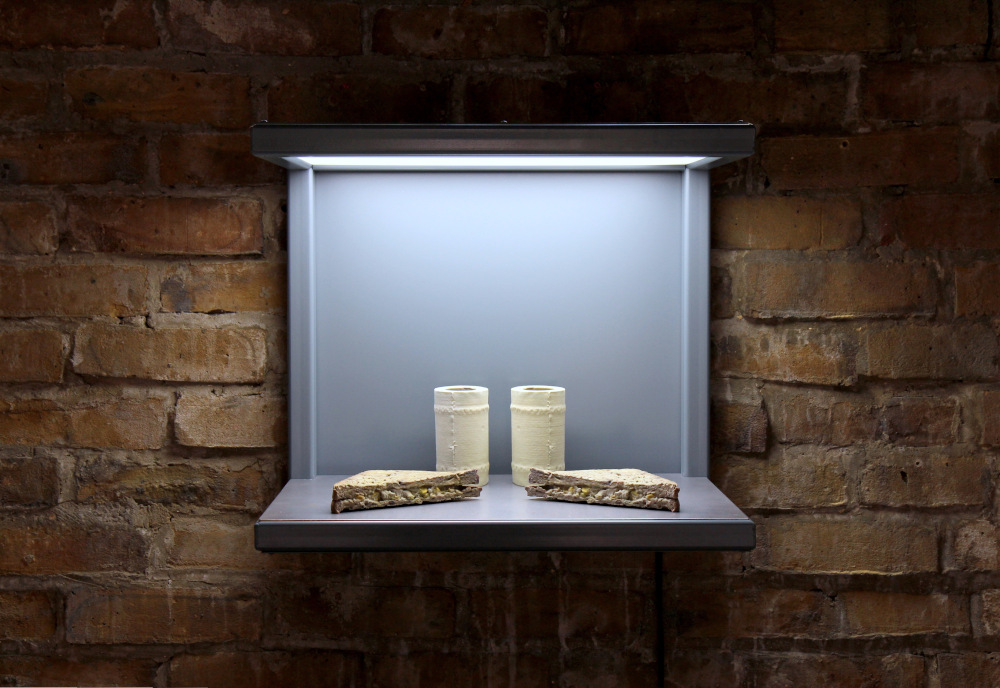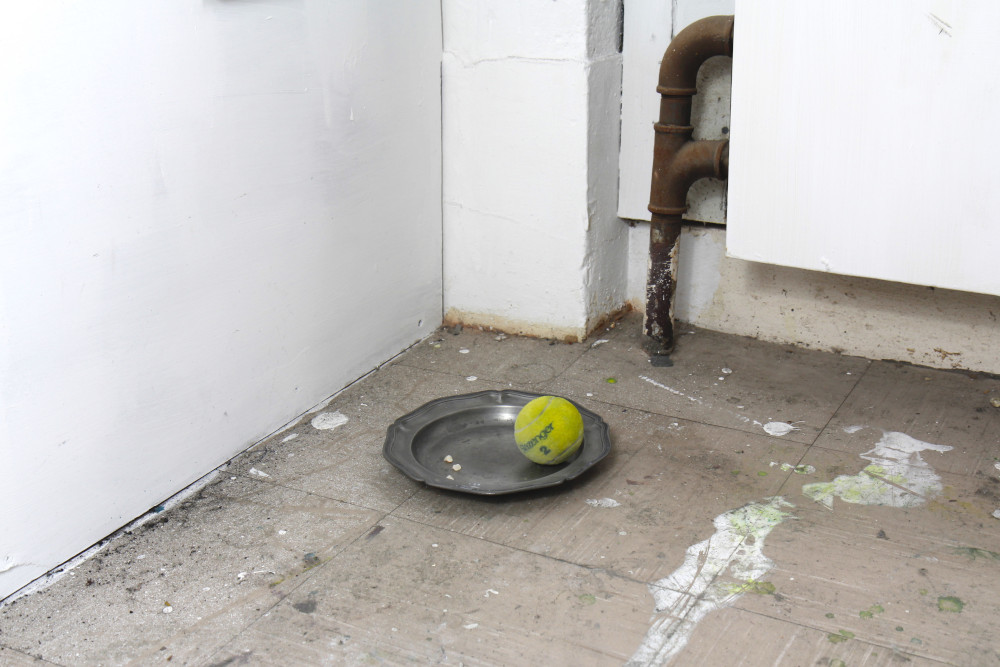Victor Seaward

Elements being contained or housed feels like it emanates throughout your practice. Can you talk a bit about this recurrence?
Putting something in a box or on a shelf is a simple act, but I’ve always been interested in how it has the ability to transform the unremarkable into something with meaning and allure. The objects seem to transcend their materiality into something more than the sum of their parts. This process is analogous to the act of putting things into a gallery or museum: there is a transformation whereby the quotidian somehow becomes worthy of contemplation.
There are myriad possible arrangements and it’s a never-ending curatorial decision, an attempt to anthologise the objects that I hoard. The hardest part is deciding when a particular arrangement is the one, and this is often an abstract feeling that it somehow seems ‘right’.
For me, a Joseph Beuys vitrine is total perfection. I’ve always been intrigued by the visceral objects he placed inside, and the spiritual significance he imbued upon them. I would love to make some like him but lack the personal mythology to do so.
My use of containment has always been tied to a museological or curatorial paradigm, but recently I’ve been thinking of enclosure in a biological sense - protection, shielding, and gestation. In this sense, enclosure is about survival and seems like a more interesting realm to explore.

Scale seems like it has a particular weight to you, especially in some of your more recent works. Where does this affinity draw from?
The work I make is often small in scale, and frequently there is a technical necessity for this: concrete can only be so large before it becomes impractical and 3D printing is unavoidably limited in terms of size. However, there is a temptation to assume bigger is necessarily better, but I’m not sure this is always the case. I think a small artwork can say just as much as a large one. Of course, sculpture or painting encountered on a bodily scale can be transcendent, but so can being drawn into a work that requires close looking and inspection. It’s a different kind of encounter that is required from the viewer, and one that I perhaps find more interesting.

The intricacies and detail in your pieces stand out. Do you find yourself grappling with perfectionism at times?
Very much so. People are quite often shocked at how much of a shit hole my studio is on a day to day basis - but all the concentration and precision goes into the work. I’m perhaps overly concerned with finish - it has to be right - and in most cases for me that requires something close to perfection. Even though we’re moving to a more digitalised experience of art, an artwork has to hold up when viewed in person. The goal is to make work that offers more in the flesh than digitally - the camera lens seems to have a forgiving nature that you have to fight against. That is not to say I don’t enjoy messy abstract painting with finger marks all down the edge of the canvas. That is the right kind of finish for that kind of artwork. But a Donald Judd is impeccable and so it should be.
I was once told that one can imbue an artwork with dignity - and that’s something that really resonated with me. That means every little detail should be considered, executed to the best of your ability, without any shortcuts. The vitrines I make all have ‘keyholes’ milled into the reverse for hanging (this takes an extra 3 hours of work for something only the person installing it would see), TIG welded mitre joints, hex-key button head machine bolts instead of pop rivets, and are all powder coated for a uniform finish. Even though most people don’t notice these things, It’s about taking that extra step that might cost more or take more time because it stays true to the language of the material. The artwork is ultimately reified by all these decisions, and it’s this kind of detail which distances the work away from being simply a design object.

Sometimes your works will feature items with a rich history to them, many times in the immediate vicinity of parts of the work you have created yourself through modern methods like 3D printing. Can you go into the significance of these contrasting items?
Juxtaposition of different objects is well-trodden ground but something I am nonetheless seduced by. Often I like to really think about where these things have come from, and the stories embedded within their materiality.
I have a small collection of ancient Egyptian Ushabti - small ceramic figures which were buried with the deceased to be slaves in the afterlife. The artisan that made this figure would have dug up the clay from the earth, mixed it with water they had collected from a stream somewhere in the Nile Delta, pressed it into the mould with their hands, before firing it and glazing it. It would have been buried for millennia before being excavated, probably by a 19th Century European, traded here and there before eventually making its way to a small dealer in Cardiff, at which point I bought it to be incorporated into an artwork. Could the artisan ever have believed this small object would have survived thousands of years? Could they possibly have contemplated the world it would eventually find itself in? And what does it mean for it to be placed next to a 3D printed scan of the brain - made by an electronic machine in the digital epoch? These juxtapositions are not necessarily resolved and are more like open-ended questions that I’m not sure I have the answer to.
This leads on to thinking about the work we all make now. Will it survive 2,000 years? And will the world be as drastically different as Old Kingdom Egypt to present-day London? Undoubtedly. If our species survives that long then it will be a world beyond our comprehension, especially considering the technological singularity is predicted to happen in 2045.

That thinking about inception, history and longevity becomes even more layered as the hyperreal objects you print do a convincing job of imitating their source materials. Do you feel the playful deception is by-product or an objective of your 3D prints?
Probably the latter. The printing process I use is called ZCorp, and it prints objects out of a gypsum-based substrate in full colour. The prints that come out are pretty bloody convincing even when viewed fairly close. But when you really inspect them, you can tell there’s something ‘off’ about them, and this ‘falling apart’ interests me. People often say they look mouldy - and can find them quite off-putting as a result. This perhaps has something to do with the Uncanny Valley principle.
I also think the prints act as close as you can get to an object based understanding of simulacra: a faithful imitation without retaining the actual essence of the original. All the objects start as real world things which 3D scanned and then printed, and I find it interesting that you can physically manifest a copy of an object with simply a series of 1s and 0s.
They also fit into the lineage of sculptural Trompe-l'œil in an interesting way. Whereas Gavin Turk or Tony Matelli painstakingly paint their bronze casts of bin bags or weeds, I can simply hit print - and get multiple copies of the original. It’s easily won, and work of art in the age of mechanical reproduction but in a manner Benjamin could never have imagined.

When we met recently you eluded to the fact that you felt that the lockdown period had affected your practice. Can you elaborate a bit on that sentiment?
I think that the lockdown necessarily changed the way all have to work - not just artists. Before, my practice relied on over the top fabrication that I did all over London. Cutting and welding metal in Walthamstow, dropping things off and powder coaters in Tottenham, picking up 3D prints for Kensington and finally assembling things at my studio in Camberwell. We all did these kinds of things to a certain extent. Of course, this all had to stop and being unable to access my studio I had to come up with a new way to work.
I had always wanted to learn how to use 3D sculpting software properly but this required a prison like scenario to actually get to grips with. The lockdown was the perfect opportunity and transformed not only how I work but the things I want to make.
I’m now sculpting things digitally and getting them 3D printed in multiple parts. I can do this from home and the studio and it’s frankly a more sustainable way to make art. I also think the objects I’m making are far more exciting.
I’m looking more and more at the natural environment. Rather than thinking of containment as a formal human category of display, I’m thinking about containment in nature. Shells, nests, cocoons - all these things are there to protect something precious or sacred within. And this is something I want to explore in far greater depth.

I’m interested in your desire to explore the natural environment, especially in relation to shifting to a more digitally based practice. Can you talk more about what drew you towards this?
At the beginning of lockdown I decided to not think about art at all. This kind of distance from your practice can engender new kinds of thinking and new solutions to old problems. It’s an underrated aspect of creating work.
During deep lockdown, when I was in this supposed ‘switched off’ state, I went for a walk in Nunhead Cemetery and saw a bird nesting in the hollow of a dead tree. Something just clicked at that moment, and I started researching different forms of natural containment and nests - and quickly came across a weaver bird nest.
Weaver birds are native to Sub-Saharan Africa, and construct incredibly beautiful and sculptural nests. When we consider that birds evolved over 60 million years ago, the structures these birds instinctively create are extremely ancient forms of protection and nurture - that greatly precede any human form of dwelling. These nests acted as a sort of elemental ‘base form’ for me to elaborate on, and things moved quickly from there.
I had been invited to show some work at an outdoor sculpture park curated by Brooke Bennington gallery, and this was the perfect opportunity to reconcile the new direction in practice with the natural environment. I created a series of bird's nests which are currently installed on some gargantuan pine trees and are hopefully offering some form of shelter for the local avian population.
But it is curious that moving to a digital practice should give rise to looking at the natural environment more - the two almost seem incongruous. Using a programme like ZBrush allows for more organic forms to be made, but ultimately the natural environment is one of the best forms of inspiration. The shapes and structures that are created from a process of natural selection and mutation are not only beautiful but also ancient and utilitarian, in ways that I often find deeply interesting.

You can visit Victor's website at https://www.victor-seaward.com and follow his Instagram account at https://www.instagram.com/victor_seaward/.
Published 06 Nov 2020
